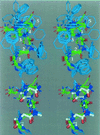NMR determination of the major solution conformation of a peptoid pentamer with chiral side chains
- PMID: 9539733
- PMCID: PMC22485
- DOI: 10.1073/pnas.95.8.4309
NMR determination of the major solution conformation of a peptoid pentamer with chiral side chains
Abstract
Polymers of N-substituted glycines ("peptoids") containing chiral centers at the alpha position of their side chains can form stable structures in solution. We studied a prototypical peptoid, consisting of five para-substituted (S)-N-(1-phenylethyl)glycine residues, by NMR spectroscopy. Multiple configurational isomers were observed, but because of extensive signal overlap, only the major isomer containing all cis-amide bonds was examined in detail. The NMR data for this molecule, in conjunction with previous CD spectroscopic results, indicate that the major species in methanol is a right-handed helix with cis-amide bonds. The periodicity of the helix is three residues per turn, with a pitch of approximately 6 A. This conformation is similar to that anticipated by computational studies of a chiral peptoid octamer. The helical repeat orients the amide bond chromophores in a manner consistent with the intensity of the CD signal exhibited by this molecule. Many other chiral polypeptoids have similar CD spectra, suggesting that a whole family of peptoids containing chiral side chains is capable of adopting this secondary structure motif. Taken together, our experimental and theoretical studies of the structural properties of chiral peptoids lay the groundwork for the rational design of more complex polypeptoid molecules, with a variety of applications, ranging from nanostructures to nonviral gene delivery systems.
Figures




References
-
- Zuckermann R N, Martin E J, Spellmeyer D C, Stauber G B, Shoemaker K R, et al. J Med Chem. 1994;37:2678–2685. - PubMed
-
- Zuckermann R N, Kerr J M, Kent S B H, Moos W H. J Am Chem Soc. 1992;114:10646–10647.
Publication types
MeSH terms
Substances
Grants and funding
LinkOut - more resources
Full Text Sources
Other Literature Sources

